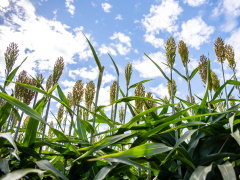Features
More bang from biomass buck
Date: 2020-04-16 16:45:08.0
Author: Jon Evans

Sorghum, which was used as the biofuel
feedstock in the current study, growing at
the Agronomy Field Headquarters in Davis,
California, US.
Photo: Marilyn Sargent/Berkeley Lab.
Despite ongoing efforts to increase the efficiency of almost every step in the production process, from biomass treatment to release of glucose to fermentation, cellulosic biofuels still struggle to complete economically with fossil fuels. One potential solution to this problem is to try to get more bang for your buck from the biomass, by using it as a feedstock for other products in addition to biofuels. So far, this has tended to involve developing ways to convert the leftover lignin, which is usually discarded or burnt, into valuable chemicals (see Finding the value within lignin), or using waste biomass from the production of food and drinks as the biofuel feedstock (see Raise a glass).
Neither of these approaches has yet completely solved the problem, but there is another potential option. This is to develop genetically engineered plants that naturally produce some high-value chemical, which can be extracted from the plant before the rest of the material is converted into biofuel.
Now, this is obviously far easier said than done, as genetically engineering plants to produce high-value chemicals tends to be quite a challenge. But exactly how much of a challenge depends on what chemical is being produced and in what quantities. So, to determine the feasibility of this approach, a team of researchers from Lawrence Berkeley National Laboratory in California, US, set out to discover how much of five high-value chemicals would need to be produced in a biofuel feedstock to make the whole extraction and conversion process economically viable.
For the five chemicals, the scientists chose ones with an existing market that can be produced by plants, as this should make it easier to transfer the ability into biofuel feedstocks such as sorghum. These chemicals comprised the fragrance limonene, the biopolymers latex and polyhydroxybutyrate (PHB), and the natural drug molecules cannabidiol and artemisinin, which are used for treating epilepsy and malaria respectively. The researchers also chose these chemicals because they vary in both the size of their current market and their price, which ranges from less than $10/kg for limonene, latex and PHB to more than $100/kg for artemisinin.
The researchers then developed technoeconomic models that included data on how much it would cost to extract each of the chemicals from genetically engineered sorghum and then convert the remaining sorghum into bioethanol. Finally, they used these models to determine how much of each chemical would need to be produced in each sorghum plant to make the whole production process economically viable at a bioethanol price of $2.50 a gallon.
Rather encouragingly, as they report in a paper in the Proceedings of the National Academy of Sciences, the amounts were fairly modest, even for the cheapest chemicals. Limonene would need to account for just 0.6% of the dry weight of the sorghum plant for the process to be economically viable, while for artemisinin the figure can be as low as 0.01%, which should be eminently achievable.
"The levels we need to accumulate in plants to offset the cost of bioproduct recovery and drive down the price of biofuels are well within reach," said team co-leader Corinne Scown.
The potential danger in this approach is that it could result in supply greatly outstripping demand for these chemicals. Scown and her colleagues calculated how many cellulosic biorefineries would need to adopt this process to meet current demand for each of the chemicals, finding that for artemisinin it was nine while for limonene it was just five. The figures were larger for latex (180 biorefineries) and PHB (1500 biorefineries), but increasing the supply of these chemicals would still cause prices to fall, changing the economics of the process for the worse.
For Scown, this shows that diversity is key, with this approach requiring lots of different plant feedstocks producing a range of different high-value chemicals. Fortunately, this study shows that the feedstocks wouldn’t need to produce these chemicals at particularly high concentrations.
The views represented here are solely those of the author and do not necessarily represent those of John Wiley and Sons, Ltd. or of the SCI.
Displaying 2 keywords used to tag this article:
- Jules Audemars-Australia Best Quali
- DG6582 Mens Moncler Down Jackets Gr
